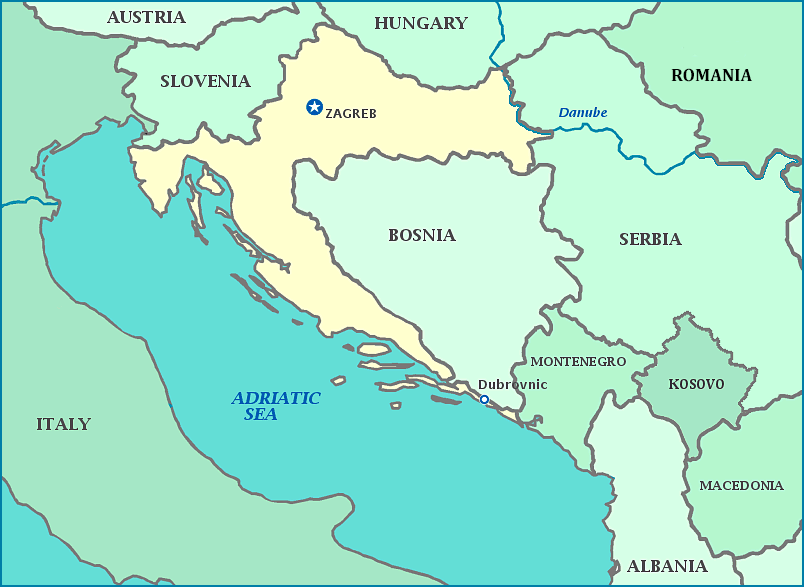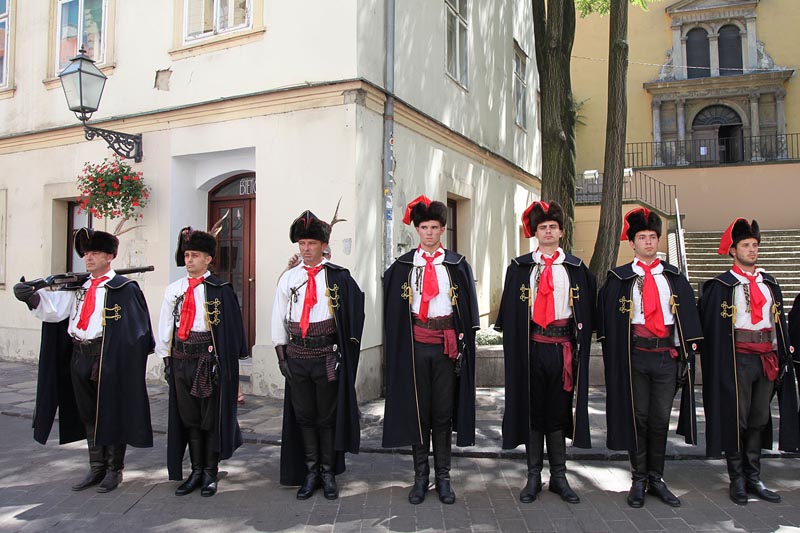When I was in
elementary school, Croatia was then part of Yugoslavia. During my 5th
grade year, Yugoslavia split up, and Croatia was one of the countries that was
born out of this. After college, I became a fan of the show ER during its final
couple of seasons. The character of Luka was from Croatia (he was played by Goran
Višnjić,
who was actually from Croatia in real life). It was through his character where I first
really heard about Croatia and Zagreb.
Croatia lies
on the Balkan Peninsula across the Adriatic Sea from Italy, surrounded by Slovenia,
Hungary, Serbia, and Bosnia-Herzegovina. Topographically speaking, the land is
fairly diverse. The coastal regions are made of thousands of islands – the two
largest are Cres and Krk (that’s right, there are no vowels. Sorry, Scrabble
players, it’s a proper noun.) The Dinaric Alps run along the coastal side of
the country. It’s also home to
quite a few deep caves (49 are deeper than 820 ft; 14 are deeper than 1620 ft;
and 3 are deeper than 3280 ft!
Great vacation destination for spelunkers, I suppose.) I’ve also seen
several spectacular photos from Lake Plitvice, which is actually made of a
network of 16 lakes, complete with cascading waterfalls, and known for its
distinguishing turquoise, blues, and greens.
It’s somewhat
unclear where the name Croatia came from exactly. It more likely used in
reference to the name of a tribe of people from this area. The word for Croatia in the Croatian language is Hrvatska, which is why their internet domain extension is .hr. The area along the southern
coast near the Bosnian border is known as Dalmatia, also lending its name to
the name of the black-and-white-spotted dog breed since it’s believed this is
where their origin is.
From the
early days, the area was explored and inhabited by Greeks and then later became
part of the Roman Empire. During
the Middle Ages, it was fought over by the Ottoman Empire as well (because
really, who wasn’t part of the
Ottoman Empire at one point or another in this area of the world?). From this point until WWI, it seems like
Croatia was at war with someone all the time. Croatia eventually became part of
the Hapsburg Monarchy and the Austro-Hungary Empire. This lasted until after
WWI with the creation of Yugoslavia. During WWII, this area was controlled by
both Germany and Italy. Jews here were either killed or transported to Germany
to be killed. It’s been estimated that only 9000 of the 39000 Jews survived the
ordeal. 1991 was a huge year for independence for many countries. Yugoslavia
broke up into the modern countries of Croatia, Bosnia-Herzegovina, Macedonia,
Montenegro, Serbia, and Slovenia (also including two autonomous regions of Serbia:
Vojvodina and Kosovo). [Russia also broke up in 1991 into 15 new countries, as
well as the Marshall Islands and Micronesia broke from the US, and it was only a
year after Germany united, Yemen united, and Namibia broke from South Africa.]
The capital
is Zagreb, and it’s roughly the size of Indianapolis (about 792,000 people in
the city, 1.1 million in the metro area). The name itself is derived from a
Croatian word meaning “to scoop,” based on a myth that a viceroy was leading
his thirsty soldiers across a desert, and out of frustration, he drove his
sword into the ground and out came water. Today it’s a modern city, with modern
infrastructure and public transportation, world-class museums (including the
Museum of Broken Relationships – yes, it’s real), orchestras, theatre, art, highly-ranked
universities (University of Zagreb), and sports facilities.
After
struggling a bit following independence, Croatia’s economy picked up and are
now considered a high-income market economy. They are mostly a service sector jobs but do have a
significant contribution from the industrial sector and tourism. Unemployment remains a problem, with
the unemployment rate being around 17.6%.
The Croatian
language is the official language and the language spoken by the majority of
Croats. It’s part of the Slavic language family, and is written in both the
Latin alphabet as well as the Serbian Cyrillic alphabet. Other minor languages
spoken in Croatia include Czech, Hungarian, Italian, Ruthenian, Serbian, and
Slovakian. Most Croats study at least one other foreign language, almost half
studying English, followed by German, Italian, French, Russian, and Spanish.
See, this is why I’ll fit in well when I retire and live in Zagreb. I started
to study some Czech years ago, I’m sure Croatian can’t be THAT far off. I’ll
pick it up.
The vast
majority of Croats are followers of Roman Catholicism. Constantine VII was the
one credited to introducing Christianity to Croatia during the 7th
century (though it may have been anywhere between the 6th-9th
centuries). Lesser followed
religions or philosophies include agnostic/atheist, orthodoxy, Islam, and a
random assortment of other.
There are
several famous people who claim Croatian ancestry. Actor Eric Bana (short for Banadinović) is part Croatian
and so is Scott Bakula (from Quantum Leap).
Former US Representative from Ohio Dennis Kucinich is part Croat, and so are a
number of NBA players. It was a Croat who created the bane of the male
businessman: the necktie. Croatian inventors also brought us the parachute and military
parachute, electric speedometer, the use of tungsten filaments in light bulbs,
the first prototypes of the self-propelled torpedo, mechanical pencils and
fountain pens, hot water bottle, anode battery, rail-car brake, the Puretic
power block used in fishing, the orbital engine, wireless energy transfer, the
world’s first hydroelectric power plant, first flyable rigid airship, dactyloscopy
(filing fingerprints), and the condiment Vegeta. Croatian engineers also had a hand in creating the MP3
player. I had no idea so much came from Croatia. Although, my favorite thing might
be the Kandit Pločice
Rum candy bar that I found at the international grocery store a couple weeks
ago. And of course, Croatia is also known for their wine and beer. Really, what
more do I need?
Up next: holidays and celebrations








No comments:
Post a Comment